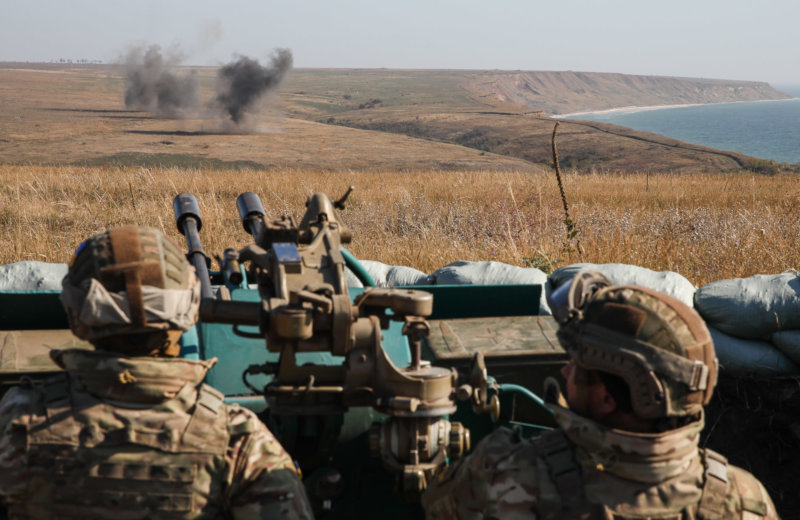The focus of Russia’s aggression against Ukraine has effectively shifted from the frontline on land in the Donbas to the expanses of the Azov and Black seas.
It is now also a sea war – and at sea, Ukraine find itself at a huge disadvantage. While the country’s ground forces saw a period of intense strengthening after 2014, the Ukrainian Navy remains extremely weak.
As of now, Ukraine’s navy includes:
- 1 frigate, the Hetman Sahaydachniy
- 1 corvette, the Vinnytsia
- 1 inshore minesweeper, the Henichesk
- 8 gunboats
- 3 amphibious personnel carriers
- Nearly 20 non-combat service craft
Most of the vessels are obsolete, most having been built between the 1970s and 1980s. Ukraine’s 3,100-ton flagship, the Hetman Sahaydachniy, launched in 1991, is one of Ukraine’s newest capital craft in military service.
The Nov. 25 incident in the Black Sea was another heavy setback for Ukraine’s already feeble navy: the Russian forces captured two small artillery boats, the Berdyansk and Nikopol, along with one harbor tug, the Yany Kapu.
Ukraine’s current fleet is no more than a pale shadow of what it used to be before Russia’s annexation of Crimea in the spring of 2014.
According to the Ministry of Defense, Ukraine’s fleet formerly had five corvettes, a frigate, two landing ships, a submarine, and 49 auxiliary vessels. The total number of active service personnel was over 15,400.
As a result of the Russian invasion, Ukraine lost over 50 vessels of various types, or more than 70 percent of its power. Moreover, one-third of its personnel, including several high-ranking officers, defected to Russia. A number of key naval bases located in the strategically important Crimean peninsula were also lost, along with their advanced defense infrastructure.
Total losses in financial terms were as much as $150 billion, according to Ukraine’s Naval Command.
Ukraine has since managed to regain possession of nearly 35 vessels held by Russia, but the country’s potential as a regional maritime power has been torpedoed for years, if not decades, ahead.
Moreover, in the years after 2014, as Ukraine concentrated on the rebuilding its army by boosting its defense spending and reforming to meet NATO standards, the navy, in contrast to Ukraine’s land forces, which were constantly engaged in combat in the Donbas, was never a top priority for Ukrainian military commanders.
The breaking point came in the spring of 2018, when Russia completed the building of a bridge over the Kerch Strait between occupied Crimea and Russia. Having secured full control of the strait, Russia started treating the Azov Sea as an inland water body and started harassing and impeding freight shipment crossing the sea to the Ukrainian ports of Mariupol and Berdyansk, inflicting heavy economic loses on Ukraine.
This was in clear violation of a 2003 treaty with Ukraine that placed the Azov Sea under the shared sovereignty of both countries.
The situation escalated rapidly in the following months, and together with squeezing Ukraine out of the region, Russia also started intensely amplifying its military presence in the Azov.
By late October, Russia’s newly emerging flotilla in the Azov Sea alone consisted of over 120 craft of various types, according to the head of Ukraine’s State Border Service Colonel General Petro Tsyhykal.
Russia’s power in the region included, in particular, corvettes carrying Kalibr cruise missiles, patrol boats, and amphibious personnel carriers. The Kremlin also has at its command the huge force of the Black Sea fleet in the occupied Crimea, as well as the powerful air and land capabilities of its nearby South Military District.
According to deputy chief of Ukraine’s Chief Intelligence Directorate Vadym Skybytskiy, Russia since 2013 has modernized the whole of its airbase network and its combat aircraft are stationed in close proximity to Ukraine’s territory.
“As of now, up to 500 tactic combat aircraft and 340 army aviation helicopters are concentrated along Ukraine’s border,” the official said on Nov. 26, adding that many of Russian pilots had gained combat experience in Syria.
In this situation, Ukraine has found itself practically defenseless even in the tiny Azov Sea; its basic military capabilities in the basin included only two coastguard stations in Berdyansk and Mariupol, equipped with a small number of old patrol boats and lacking even the basic capabilities of maritime warfare, such as anti-ship missiles, or coastal radar stations.
Facing public indignation over Russia’s aggressive takeover of the sea, Ukraine’s leadership took some overdue steps to improve the situation and boost its military presence in the vulnerable region.
Over the past few months, Ukraine has redeployed several newly produced small craft to the Azov Sea, such as two Gurza-class armored gunboats, and two newly-built Centaur-class small assault craft.
Besides, the Armed Forces have also conducted a number of brigade-level live-fire maneuvers, simulating defensive operations against a Russian amphibious assault on the Azov Sea coastline.
Another milestone was reached on Sept. 27, when Ukraine’s leadership finally agreed to take delivery of two U.S. Island-class patrol boats as free military aid from the United States, after nearly four years bureaucratic ping-pong between government agencies.
Together with the newly-produced small gunboats, the Island cutters were meant to emerge as the core force of a brand new naval base in Berdyansk, the creation of which the Ukrainian government announced on Sept. 16.
The Nov. 25 incident in many ways derailed these efforts: Two of the vessels captured by the Russians, the Berdyansk and Nikopol, were launched between 2016 and 2018 as part of the policy to counter Russia’s dominance in the Azov.
Nonetheless, during a briefing in Kyiv on Nov. 26, Ukraine’s top naval commander, Admiral Ihor Voronchenko, said the Armed Forces were potent enough to repel an all-out Russian invasion in the Azov Sea, citing the strong coastal defenses and battle-hardened marine forces in the region.



